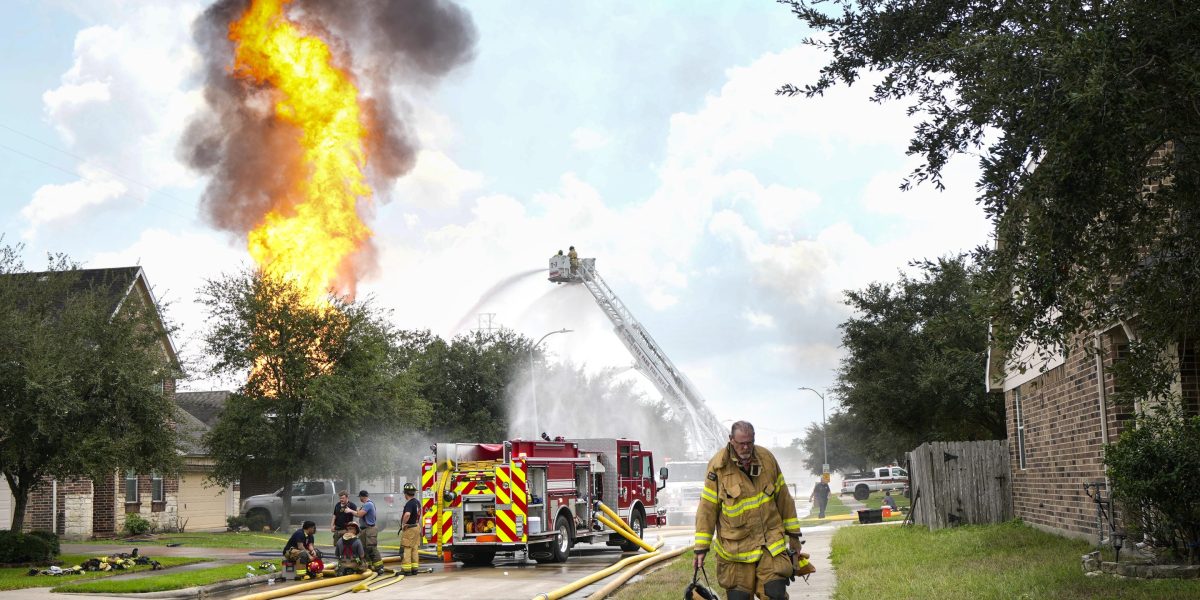Although the fire was getting smaller, the disruptions caused by the Monday morning explosion in a grassy corridor between a Walmart and a residential neighborhood left some locals increasingly weary. On Tuesday, people could be seen returning to their homes to get clothes and other items before quickly leaving again.
“We literally walked out with the clothes on our backs, the pets, and just left the neighborhood with no idea where we were going,” Kristina Reff said. “That was frustrating.”
Over 36 hours after the blast — which shot towering flames like a blowtorch above the suburbs of Deer Park and La Porte — authorities have provided few details about the circumstances leading up to the explosion.
Investigators said it happened after the driver of a sport utility vehicle went through a fence near the Walmart and struck an above-ground valve. As of Tuesday evening, authorities had not still not identified the driver or said what happened to them.
Deer Park officials have said police and FBI agents found no preliminary evidence to suggest the explosion of the pipeline, which carried natural gas liquids, was a coordinated or terrorist attack. In a statement Monday night, the city said it “appears to be an isolated incident” but officials have not provided details on how they came to that conclusion.
The car was incinerated by the explosion, which scorched the ground across a wide radius, severed power transmission lines, melted playground equipment and ignited some homes.
The valve, which appears to have been protected by a chain-link fence topped with barbed wire, is located within a long grassy field where high-voltage power lines run. Several pipelines run underground.
Authorities evacuated nearly 1,000 homes at one point and ordered people in nearby schools to shelter in place. By Tuesday afternoon that number was down to just over 400.
“The fire is still burning, but the good news is that the pressure within the pipeline is continuously dropping, which means we are getting closer to the fire going out,” Harris County Judge Lina Hidalgo said in a statement.
Operators shut off the flow after the explosion, but Hidalgo has said that 20 miles (32 kilometers) of pipeline stretched between the two closed valves and the chemicals inside had to burn off before the fire would stop.
Robert Hall, a senior advisor at the nonprofit Pipeline Safety Trust, said it’s not surprising that it’s taken more than a day for the material to stop burning.
“You’re talking about 20-inch pipelines and miles between valves, so it takes a long time to burn down,” Hall said.
On Tuesday, the Texas Railroad Commission that regulates the state’s oil and gas industry said its inspectors only will enter the site after it is deemed safe by emergency authorities.
Houston is the nation’s petrochemical heartland and is home to a cluster of refineries and plants and thousands of miles of pipelines. Explosions and fires are a familiar sight, and some have been deadly, raising recurring questions about industry efforts to protect the public and the environment.
Hall, who previously oversaw pipeline and hazardous materials investigations for the National Transportation Safety Board, said there are few regulations that govern the location of pipelines near homes and businesses.
“That becomes a very local issue, community by community,” Hall said, adding that some jurisdictions require bollards — sturdy pipes filled with concrete — to prevent vehicles from crashing into sensitive infrastructure.
Hidalgo said Tuesday that Energy Transfer, the Dallas-based owner of the pipeline, has said it was working to isolate parts of the pipeline closest to the fire by clamping it on each side.
Energy Transfer did not immediately respond to a question about what safety precautions were in place near the valve.
Hall said regulations from 2022 aimed at reducing deaths and environmental damage from ruptures were geared toward gas lines, not those carrying liquids, and would not have applied to this pipeline. He added that many new safety regulations that have been put in place do not apply retroactively to pre-existing pipelines.
Both Energy Transfer and Harris County Pollution Control were conducting air monitoring in the area and have found no health issues, according to Deer Park officials.
Since leaving home, Reff and her family have been staying in a hotel room paid for by Energy Transfer. But they were eager to return.
“It would be nice to be in our own beds,” she said.

